Watering systems, paths, compost, what to sow now and what to eat
By Nick Nutter | Updated 30 Sep 2022 | Andalucia | Organic Garden |
Login to add to YOUR Favourites or Read Later
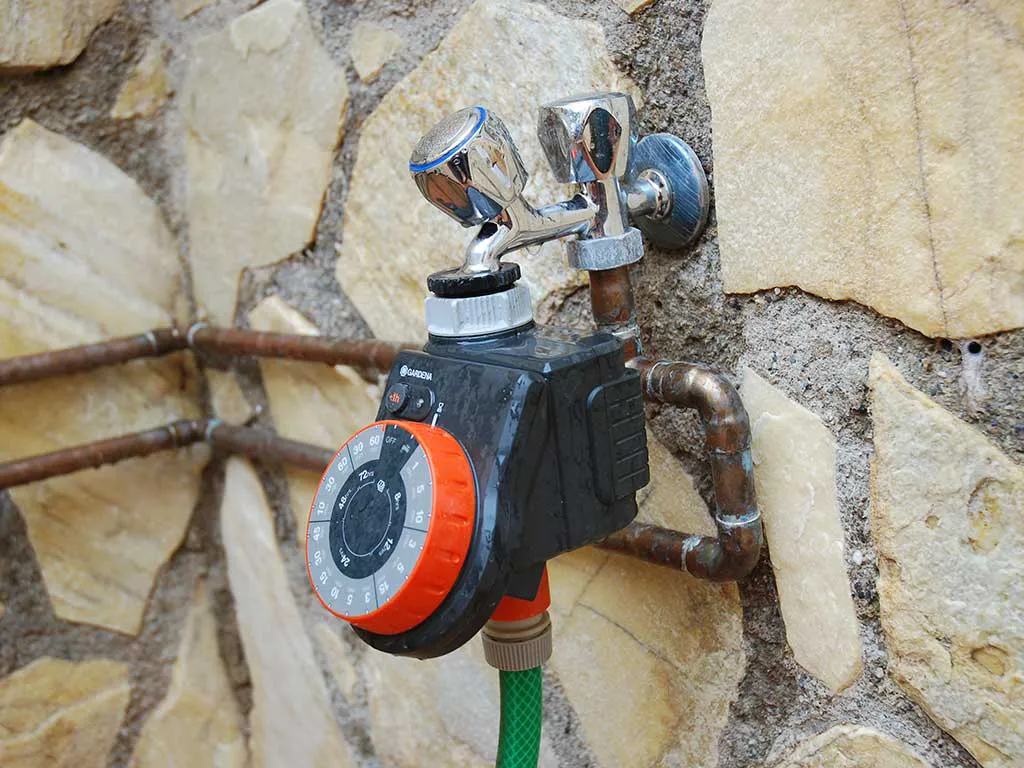
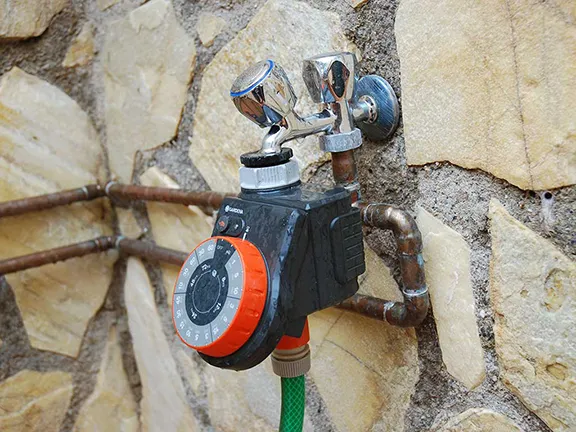
Watering system
We had a fair bit of rain during April considering Huercal Overa is supposed to be on the edge of the last semi-desert area in Europe. The wild flowers in the ramblas and mountainsides loved it, giving a colourful display right through until mid-May. Towards the middle of May though, the temperatures started to rise, rain became less likely, and my thoughts turned to a watering system.
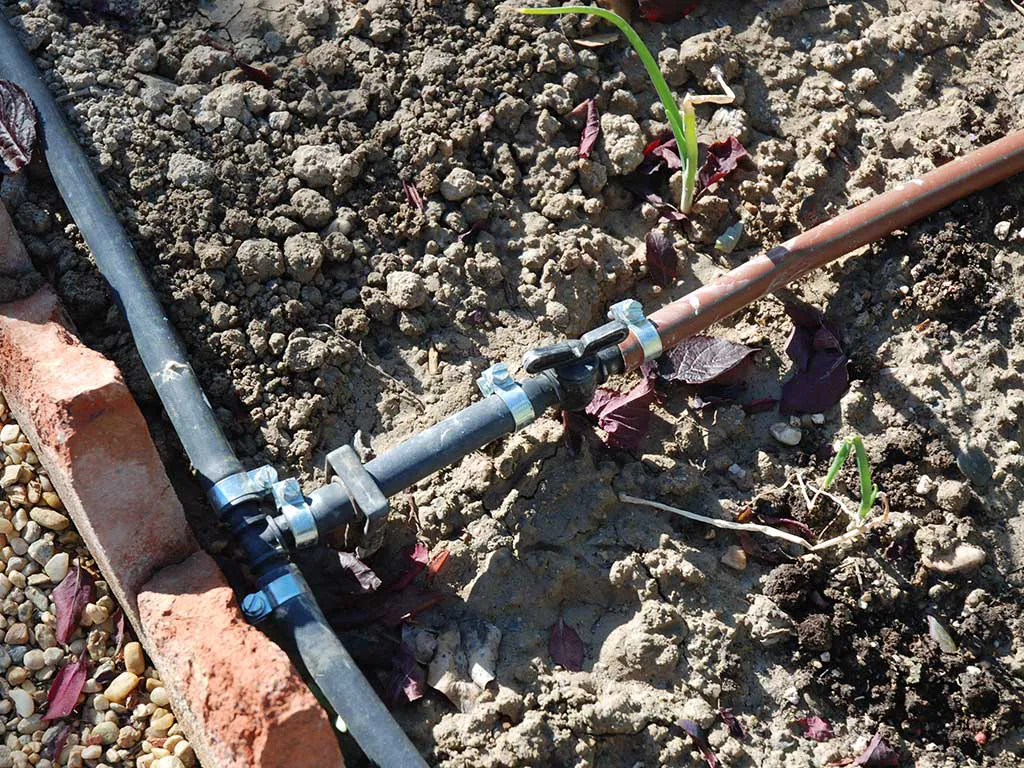
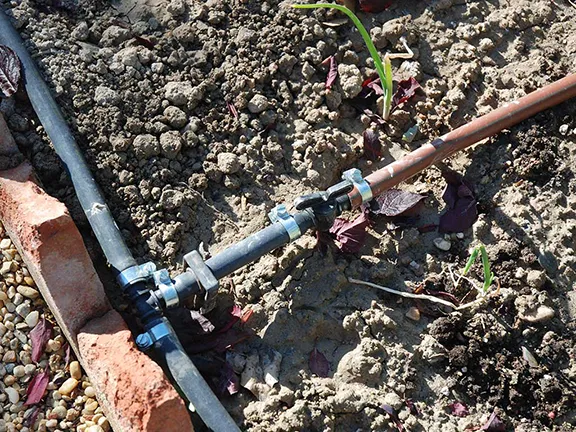
Watering system
Julie and I tend to go away for a few days at a time and the kitchen garden particularly needs water every day. I have found that, when it comes to watering systems, the simpler the better. My basic system is a garden tap feeding through the lowest spec Gardena or Hozelock timer. I could go for even cheaper Chinese versions but I have found that, over the years, the Chinese versions stop working after one season whilst the brand names last three or four years before they pack in. As regards the timer itself. They are a bit like a washing machine, the fewer programmes there are, the easier they are to set, the less there is to go wrong. One last thing, put the tap and timer in the shade. The strong sun soon fades any colour on the timer controls so resetting the thing next season is a bit of a challenge, especially given a memory like mine. The sun also tends to rot the case, making the whole assembly brittle.
Now I am aware that there are people out there that enjoy this sort of thing. Let them be reassured that there are watering systems that are WIFI, computer controlled, with soil water content meters and rain sensors, temperature gauges, pumps, valves, pressure reducers and other bells and whistles that can be monitored from your mobile phone or PC no matter where you are in the world. It’s your choice.
Once through the timer, a hosepipe leads to the vegetable garden. Here a combination of black plastic 16mm pipe and brown irrigation pipe take the water around the plot. I use straight runs down each vegetable row and a spiral sort of pattern through patches such as the herb garden. Each row is set roughly 65 cms from its neighbour. The brown irrigation pipe has holes in it that allow water to escape. Use 16mm ‘T’ pieces, end stoppers, right angled bends (don’t try to bend the pipe sharply it will kink and prevent water flow) and in line taps. It is well worth drawing out your irrigation plan to begin with to calculate the lengths of pipe you will use, how many connectors you need and so on.
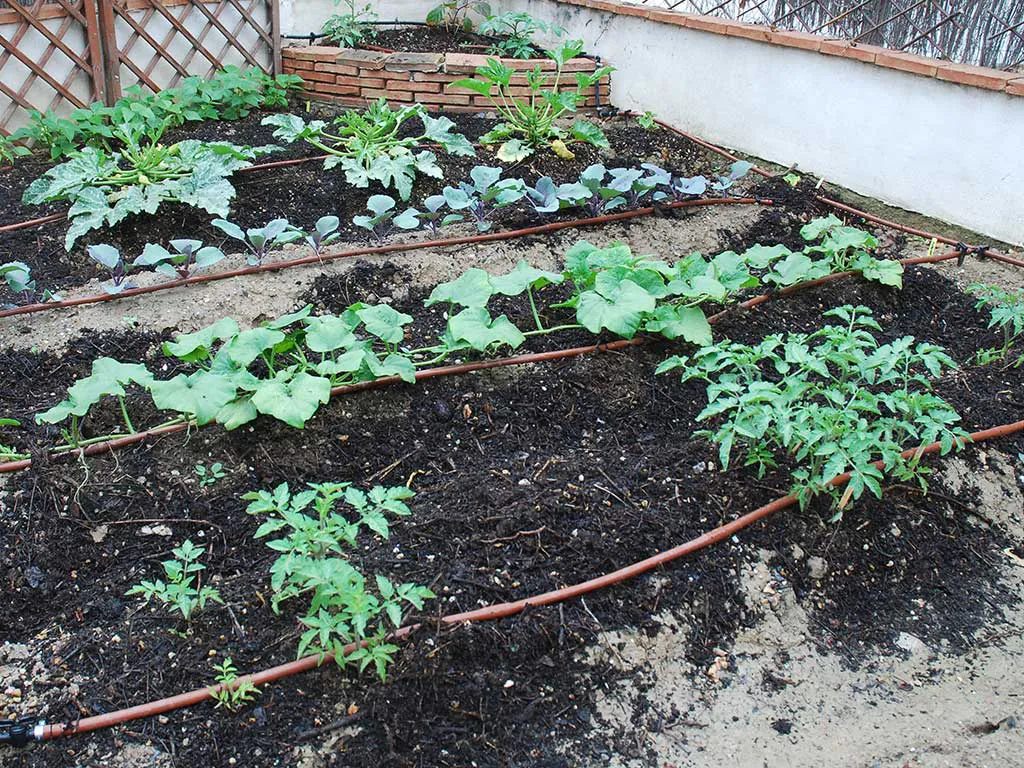
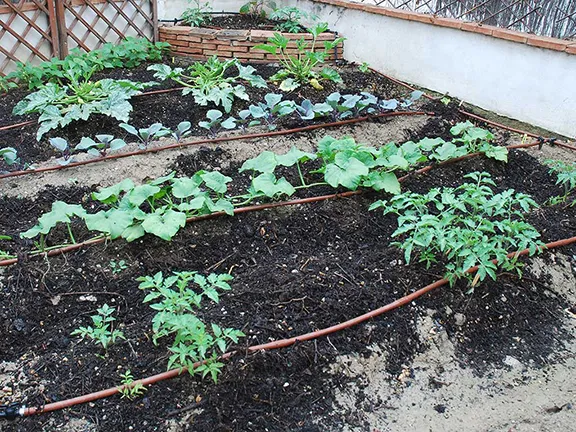
Veg patch
In line taps are inexpensive and allow you to switch off water down individual runs if you have an unplanted row. They save water and allow better control of how much water each row receives; some plants need less water than others. The initial expense will be recouped by reduced water bills.
I also use butano pipe clips to reinforce every pipe to fitting join. This prevents the pipe being pushed from the fitting by the pressure of water, especially if the system is not using all the water supplied from the tap. I will explain this in a moment.
Hose pipe to fitting joins are reinforced with jubilee clips for the same reason. Jubilee clips are more expensive than butano clips but hosepipe tends to be a ‘softer’ plastic than the irrigation pipe, so the join needs that extra grip.
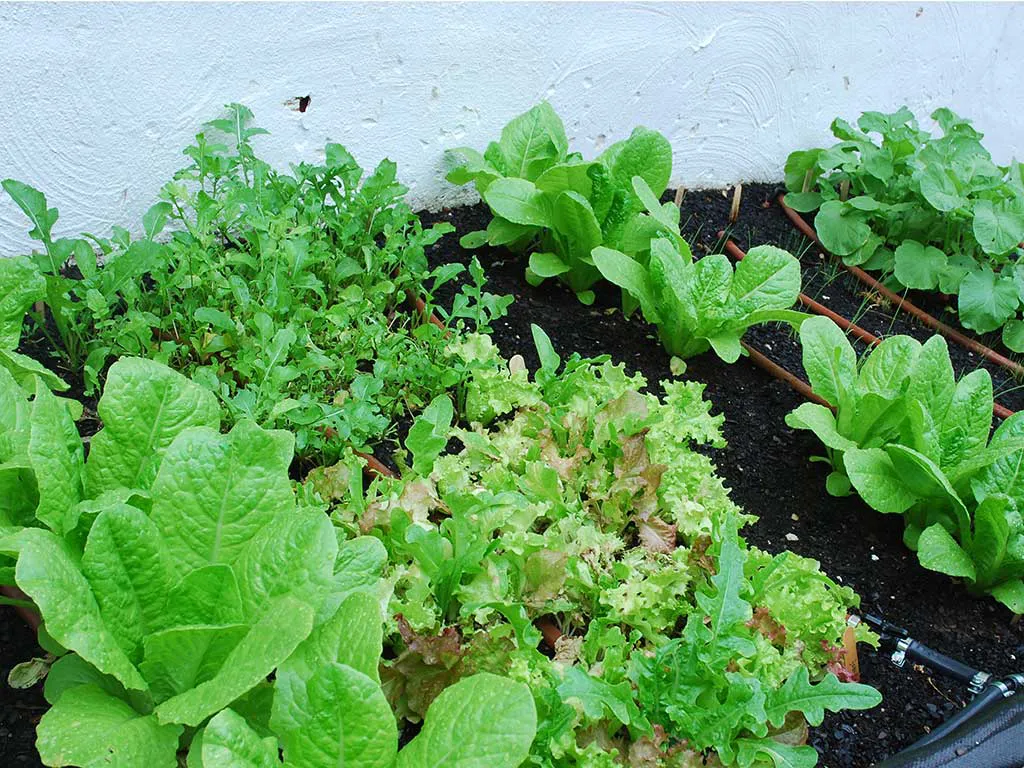
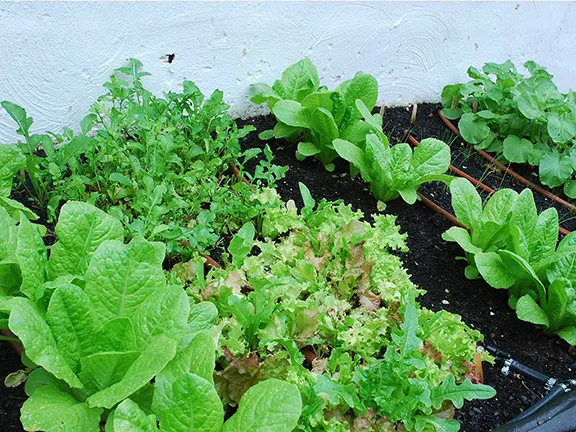
Raised bed
You need to know how much water actually comes out of the tap. Water pressure is measured in bars. One bar will push water uphill by 10 metres (useful to know if you have a hilly garden or raised beds.) Many water supplies in Spain have a pressure gauge somewhere near the water meter that will tell you at what pressure the water is supplied. This initial pressure may not be the pressure that comes out of your garden tap depending on how your water pipes were built into the house, so here is a quick and dirty way to calculate the pressure at an individual tap.
Put a measuring jug beneath the tap. Turn the tap on for 6 seconds, measure the seconds on your mobile phone, stop watch, or count 1 and 2 and 3 and … 6 and. Multiply the amount of water in the jug by 10. If the jug filled to the half litre point you would have a water pressure of 0.5 bars and a water flow of 5 litres per minute. I tried this recently and ended up soaked. The jug filled in less than 2 seconds and shot water into my face. I then used a watering can and found I had 4.5 bars (4.5 litres delivered in 6 seconds) of pressure delivering water at the rate of 45 litres per minute. Now that can make quite a lake if one of your pipes becomes disconnected whilst you are away for a few days.
The pressure at the tap will not always be constant. The house has other demands on the water supplied from the main valve at the water meter, washing machine, dishwasher, showers etc. One of the points to bear in mind when deciding when the irrigation system should be switched on. The wife taking a shower can upset all the careful calculations you will be making so, at this point, I advise you to get a cup of coffee and a note pad and pencil.
You can install a pressure regulator between the tap and the automatic timer. This reduces the water pressure to a known, constant pressure depending on the regulator. In my opinion it is just something else to go wrong, especially with a water supply that is not at a constant pressure to begin with. Pressure regulators need a certain minimum pressure to work properly. Most automatic timers need a minimum water pressure of 0.5 bars. They also have a maximum allowed pressure that can be as high as 10 or 12 bars. However, the hose to timer coupling is normally a ‘clip on’ type fitting and they will blow at high pressures. In my experience a new coupling will take 5 bars before blowing and less as the coupling deteriorates over the years. I renew this vital connection every two years. So, pressure regulator or no regulator, it has to be up to you.
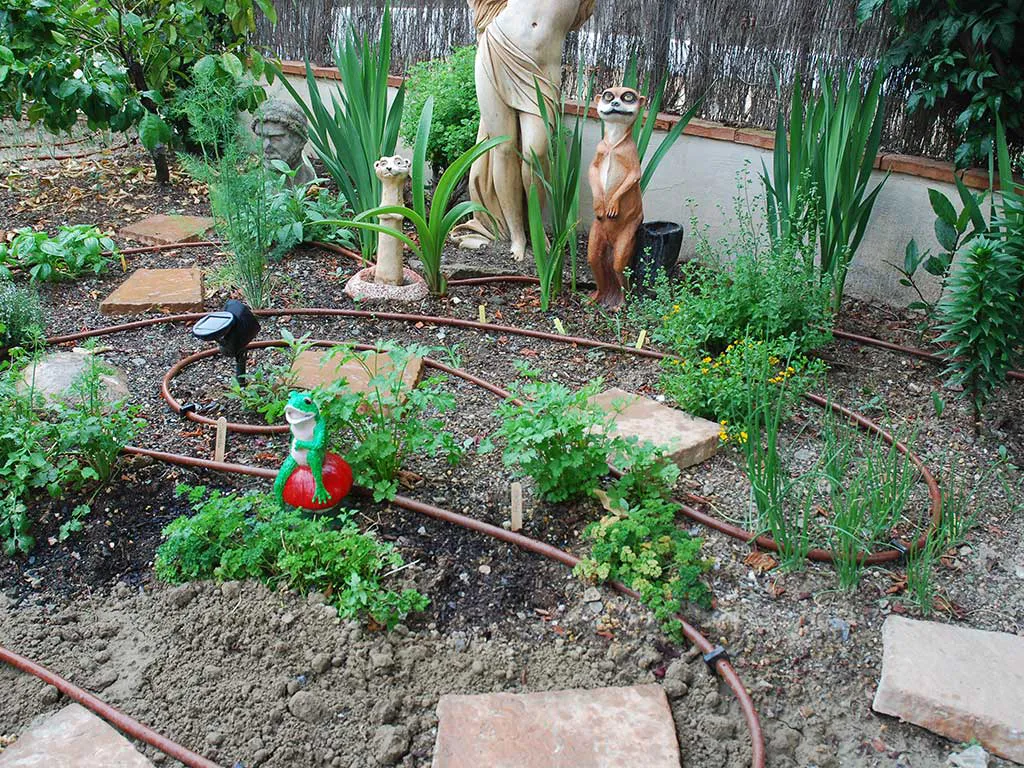
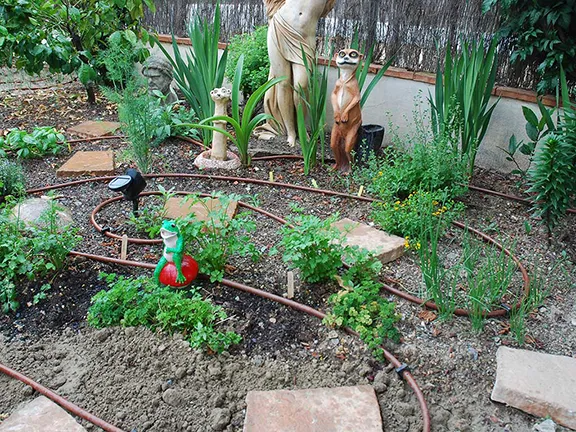
Herb garden
You should now know how much water comes out of your tap every minute. A bit of physics here. The water will eventually be pushed through the irrigation pipes. As it reaches each hole in the pipe, a bit of water escapes and the water pressure downstream of the hole is reduced by a corresponding, very small, amount. Eventually, if the water meets enough holes, there is no pressure left and no water coming out of downstream holes. There is a finite length of irrigation pipe it is possible to use. If you are working on a hill then you also need to work out the elevation of the pipe. Remember, 1 bar, i.e., 10 litres of water per minute, will only push the water uphill 10 metres at which point water pressure will be zero and no water will emerge from your holes.
The inline drip tubing I use has an emitter flow rate of 2 litres per hour. Each pair of holes has a basic pressure compensator. Holes are set at 35 cm spacings. 1 bar of tap pressure will deliver 600 litres of water per hour which in turn will feed 180 holes or 63 metres of pipe. I use about 200 metres of pipe in total so my 4.5 bars is more than I need, hence the butano clips. Each pair of holes waters about 1600 square centimetres of ground (40 cms x 40 cms, there is a bit of overlap).
Now, the big question. How much water should I supply to the plants? As a guide, a tomato plant needs 1 litre of water per day in spring and up to 2 litres per day in the heat of our summers. Courgettes and cucumbers are about the same. My tomatoes are planted in pairs 0.5 metres apart and about 1 metre between each pair. I find setting the timer to 45 minutes per day sufficient at the moment and up to 90 minutes per day in the height of summer.
The flow down each row can be further regulated by the in line taps so, stuff that needs less water such as onions and root veg can have their supply reduced accordingly. A bit of trial and error will soon give you the perfect watering configuration for your soil type, amount of shade and other variables.
Over time, water is the greatest expense. I use about 900 litres per day, just short of a cubic metre. That will increase to about 1,500 litres per day in summer. Water costs per cubic metre vary so the total cost depends on how much you pay for your water. However much you pay for water, it makes sense to use it wisely. I have already mentioned online taps. The timing of your watering is also important. Watering just after dark, late evening, is the best time. Evaporation is low and the water has time, overnight, to penetrate to the roots of your plants.
I recently met a man who had installed an all singing, all dancing WIFI watering system and jokingly asked if he also liked playing with model trains. He proudly took me into his ‘man shed’ to show me his new project, building a 00 scale model of Baza railway station. I wonder what Julie would say?
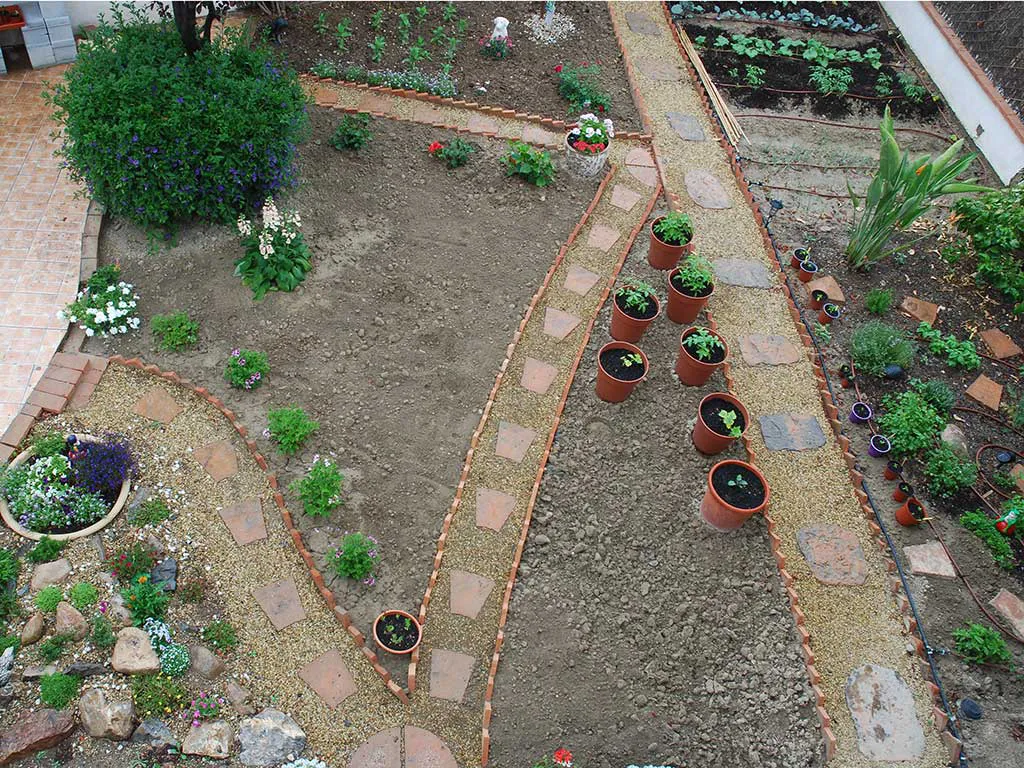
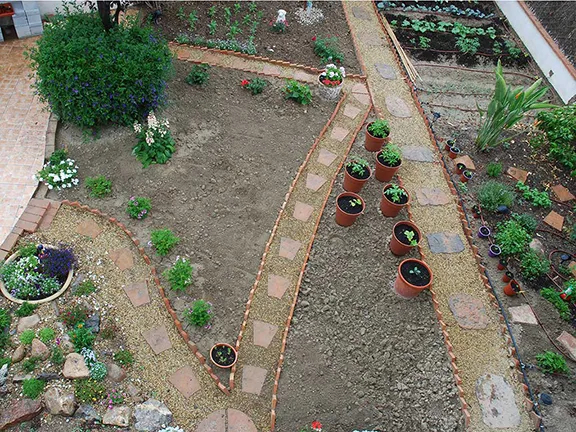
Paths finished
With a breath of relief, I finished the paths this month. I was wanting to have them done by the time the weather became really hot. We can see now how the garden will develop.
Julie’s raised bed started to provide us with our first pickings this month, it really does not take long to taste the first results of your efforts. We have been eating radish, rocket, lettuce and mixed leaves. We eat a lot of salad. By the end of the month, we were self sufficient in these vegetables plus our herbs; parsley, coriander, tarragon, mint, bay, thyme, sage and dill. The first of our courgettes were grilled with butter on the last Sunday in the month and I will be picking the first broad beans on the 1st June. The basil, also grown from seed, is ready to be topped so that it will bush out. There will be no stopping it then. Sounds like a caprese salad this week.
Red cabbage, grown from seed, were planted out this month and I sowed a row of carrot seed. They germinated in 8 days so I must be doing something right. Ready to be transplanted are the sprout plants that Julie has grown in the raised bed. The tomatoes, aubergines, peppers and chilis are all in their permanent positions now, the bush tomatoes, aubergines, peppers and chilis are in large pots, and the cane tomatoes are in a row in the vegetable garden, a little late I know but we wanted to grow them from seed rather than buying forced plants from the viveros.
In the last few days of the month, I opened up the first compost bin. It was partially decomposed but I was desperate for some compost for the squash and courgettes so I riddled the half decomposed stuff and obtained two full wheelbarrow loads of useable compost. The remainder went on the top of the second bin to seal off the only just begun compost. The second bin is now full and covered with a black plastic sheet weighted down with a couple of bricks. The first bin will be filled over the next couple of months. Remember to keep your compost just moist. We throw a basin of washing up water over the bin every week or so and find that is ample.
Well, the sun is shining; time to stop writing and start weeding. Happy gardening all.